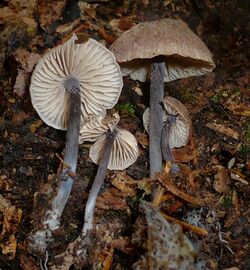Biology:Leptonia
| Leptonia | |
|---|---|

| |
| Leptonia dichroa, Czech Republic | |
| Scientific classification | |
| Domain: | Eukaryota |
| Kingdom: | Fungi |
| Division: | Basidiomycota |
| Class: | Agaricomycetes |
| Order: | Agaricales |
| Family: | Entolomataceae |
| Genus: | Leptonia (Fr.) P.Kumm. (1871) |
| Type species | |
| Leptonia euchroa (Pers.) P.Kumm. (1871)
| |
| Synonyms | |
|
Agaricus trib. Leptonia Fr. (1821) | |
Leptonia is a genus of fungi in the order Agaricales, frequently treated as a subgenus of Entoloma. Called pinkgills in English, basidiocarps (fruit bodies) are agaricoid, mostly (but not always) mycenoid (like species of Mycena) with slender stems.[1] All have salmon-pink basidiospores which colour the gills at maturity and are angular (polyhedral) under a microscope. Recent DNA evidence has shown that at least 12 species belong in Leptonia in temperate Europe and Asia.[1]
Taxonomy
Leptonia was introduced in 1821 by the Swedish mycologist Elias Magnus Fries as a "tribe" of Agaricus comprising small, slender agarics with convex to flat caps and pink spores.[2] In 1871 German mycologist Paul Kummer raised the tribe to genus level.[3] The name has been used by many subsequent mycologists,[4][5][6] but others have preferred to use the name Entoloma sensu lato for all fungi with pink, angular spores, retaining Leptonia as a subgenus.[7]
Recent molecular research, based on cladistic analysis of DNA sequences, has shown that Leptonia, as previously defined, is paraphyletic (an artificial grouping).[8] By excluding species unrelated to the type, however, Leptonia has been redefined as a monophyletic (natural) grouping.[1] In this new sense, Leptonia has so far been treated as a subgenus of Entoloma.[1]
The redefined Leptonia is substantially smaller than before and excludes Entoloma cyanulum, Entoloma serrulatum, and related species (now placed in subgenus Cyanula), Entoloma cocles and related species (now placed in subgenus Griseorubida), and Entoloma watsonii and related species (now placed in subgenus Rhamphocystotae).[1]
References
- ↑ 1.0 1.1 1.2 1.3 1.4 "Entoloma subgenus Leptonia in boreal-temperate Eurasia: Towards a phylogenetic species concept". Persoonia 32: 141-169. 2014. doi:10.3767/003158514X681774. https://docserver.ingentaconnect.com/deliver/connect/nhn/00315850/v32n1/s9.pdf?expires=1685664588&id=0000&titleid=75002420&checksum=1B3DB27F63D37FD58C420574EE096888&host=https://www.ingentaconnect.com.
- ↑ Fries EM. (1821) (in Latin). Systema Mycologicum. 1. Lundin, Sweden: Ex Officina Berlingiana. pp. 10, 207. https://www.biodiversitylibrary.org/page/4338023.
- ↑ Kummer, Paul (1871). Der Führer in die Pilzkunde : Anleitung zum methodischen, leichten und sichern Bestimmen der in Deutschland vorkommenden Pilze : mit Ausnahme der Schimmel- und allzu winzigen Schleim- und Kern-Pilzchen. Zerbst: Verlag von E. Luppe's Buchhandlung. pp. 94-97. https://www.biodiversitylibrary.org/item/106672#page/102/mode/1upp.
- ↑ "A revised list of British species of Entoloma sensu lato". The Mycologist 5 (3): 123–138. 1991. doi:10.1016/S0269-915X(09)80307-8.
- ↑ "A revised list of British species of Entoloma sensu lato (part 2)". The Mycologist 5 (4): 172–176. 1991. doi:10.1016/S0269-915X(09)80478-3.
- ↑ Largent DL (1994). Entolomatoid fungi of the Western United States and Alaska. Berkeley, USA: Mad River Press. ISBN 978-0916422813.
- ↑ Noordeloos ME (1992). Fungi Europaei:Entoloma sensu lato. Saronno, Italy: Giovanna Biella. pp. 760.
- ↑ "Molecular phylogeny and spore evolution of Entolomataceae". Persoonia 23: 147–76. 2009. doi:10.3767/003158509X480944. PMID 20198166. PMC 2802732. https://docserver.ingentaconnect.com/deliver/connect/nhn/00315850/v23n1/s11.pdf?expires=1685225126&id=0000&titleid=75002420&checksum=C7FFC87FF4A1FF609415D9C8CE625BB3&host=https://www.ingentaconnect.com.
Wikidata ☰ Q6528224 entry
 |

